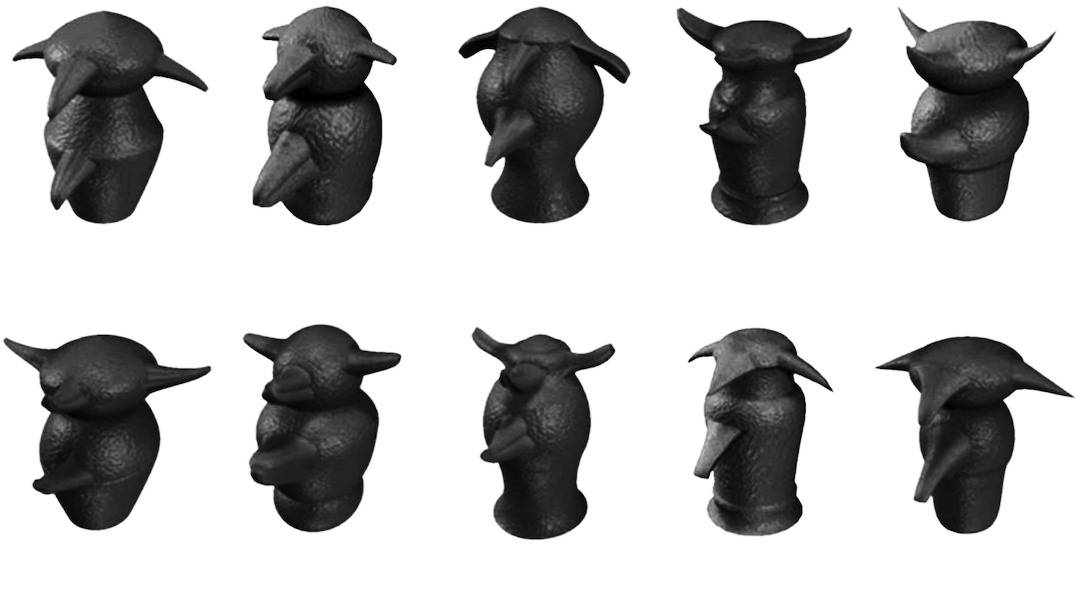
A collection of “greebles”—visual stimuli used in psychology for a variety of purposes. Greebles—like human faces—are each of them unique individuals, but have “genders” and belong to “families” and can therefore be sorted into groups. We use greebles to illustrate the two central functions of perception: grouping and discrimination. We seek to develop perceptual stimuli capable of carrying high-dimensional information while remaining immediately groupable and discriminable.
Data Perception ACTIVE
The size of the data universe—the totality of data stored on computers across the globe—for even one scientific domain is now so immense that it is not possible for humans to explore even a substantial portion of it. What's worse, this universe is always expanding, and at an ever-increasing rate. There is slim hope of ever “catching up” with this expansion in any meaningful sense, at least if we limit ourselves to exploration by conventional means. Because of this, it is commonly believed that our only hope of exploiting the total data universe to our advantage is for machine surrogates—that work much faster and never tire—to do the exploration for us. Provided that we train them well, they will retrieve the important bits and ignore the rest—or so it is believed. That this approach will make up a part of our engagement with the data universe is inevitable, but machine surrogacy is not a perfect solution. Even setting aside issues about, for example, classifier error, machine-centered approaches risk leaving important parts of data universe unexplored, because machines can only find what we teach them to find, and surely richer treasures await than those we can conceptualize in isolation from the data universe itself. The motivation for this project is to develop an alternative way of exploration, one in which our contact with the data universe is direct and in which human judgment figures centrally. We aim to develop (1) a process by which data are mapped, in part by user feedback, to perceptible features, both visual and non-visual, resulting in a customized interface for the chosen data domain; (2) a training regime, informed by work on perceptual learning, designed to develop perceptual expertise for users of such interfaces; and (3) web-based software implementation of both design process and training regime.
If successful, our research promises no less than to make new portions of the data universe available to human perception. This is, of course, the stated goal of all information visualization, but while current approaches work only on small, low-dimensional subspaces, our approach is specifically designed to handle complex, high-dimensional data. In coming to discover the principles that make for effective mapping procedures and training regimes, we will also advance the current state of empirical research into the perceptualization of multidimensional data. In particular, we expect to discover which interface elements should be fixed and which can be manipulated to match variation in the data or personal preferences. Additionally, we hope to discover the extent to which nonvisual sensory channels can be used to reduce complexity and to help make target domains more discoverable or learnable. We envision a diverse range of potential application domains, including personal health and well-being, education and learning, scientific research, and business and finance. The ambitious goal of this research program is making possible conceptual growth: new ways of conceptualizing our world, ways that depend essentially on the capacity for direct apprehension that this research aims to exploit and develop.
This ambitious research program cannot, of course, be fully completed by a single group in a few years of work. We appreciate the magnitude of the task and expect our foundational work to stimulate a cross-disciplinary exploration involving cognitive scientists, computer scientists, designers, engineers, and psychologists. Because the proposed interfaces will be multimodal and customizable, they are made for accessibility: accommodation of individual differences and impairments is a fundamental part of the system by design, which means that the research will enable and encourage involvement of diverse user communities.
